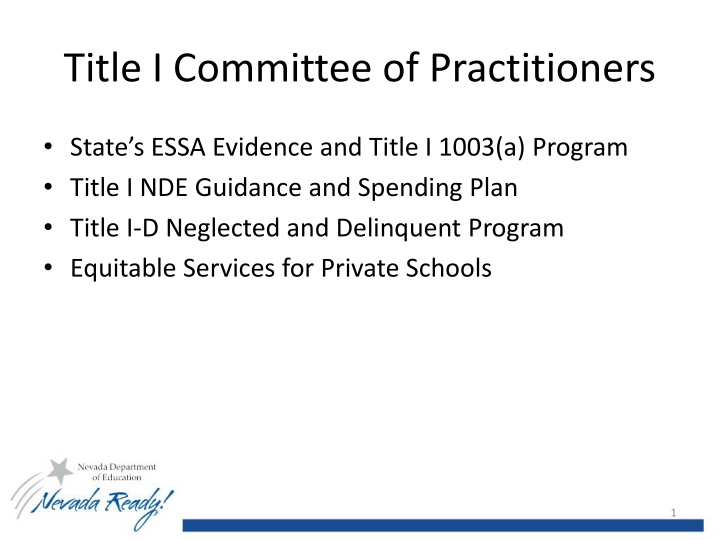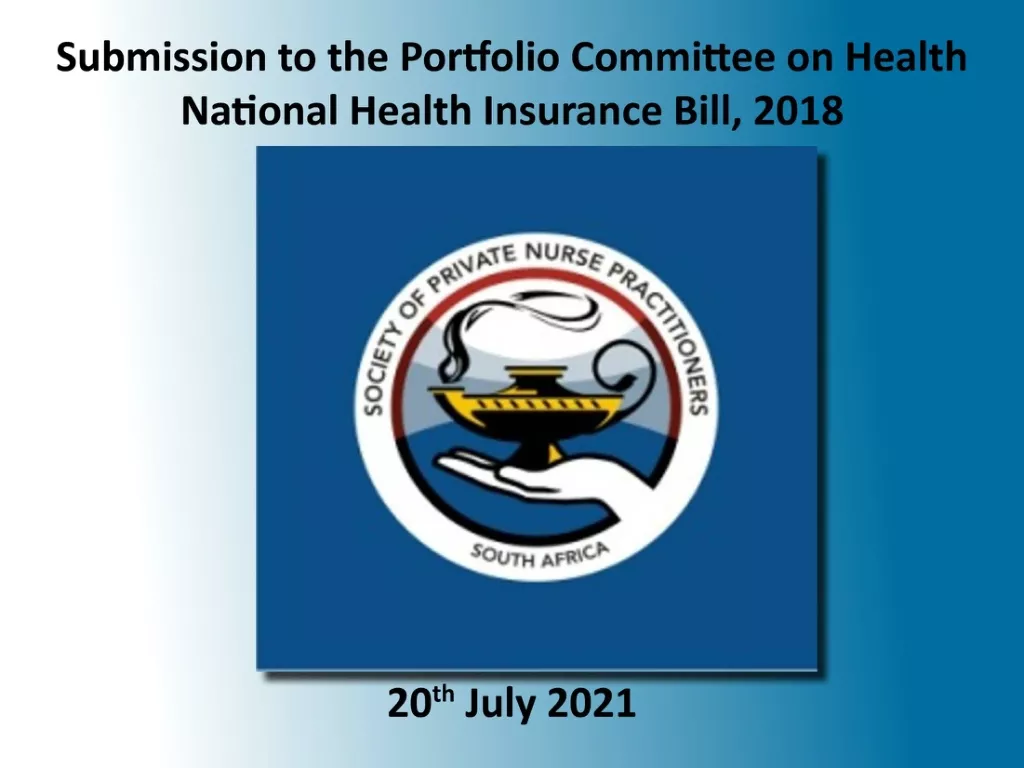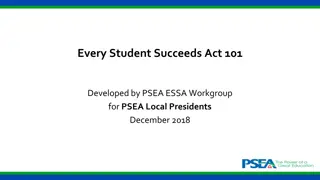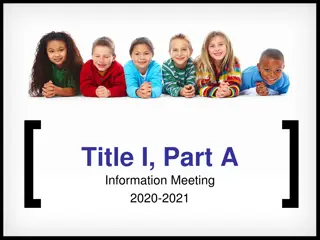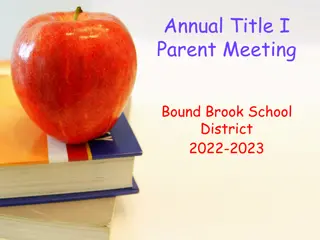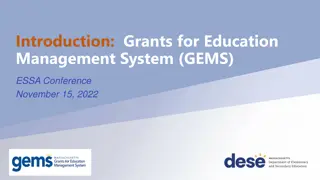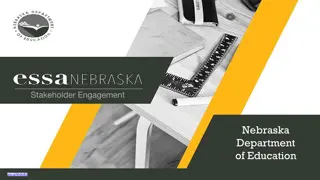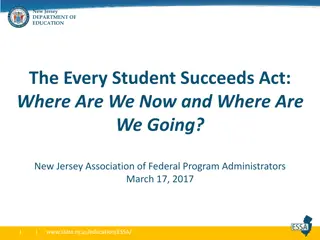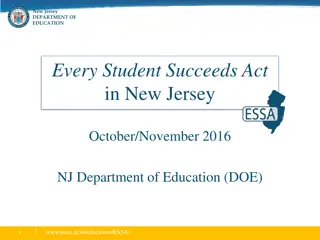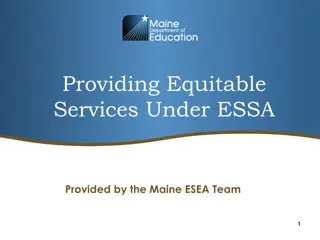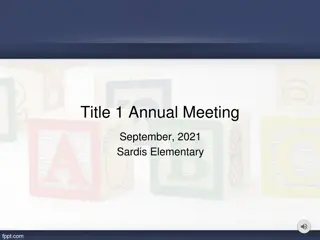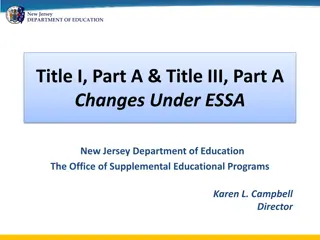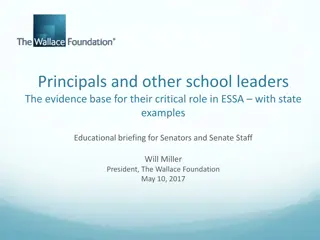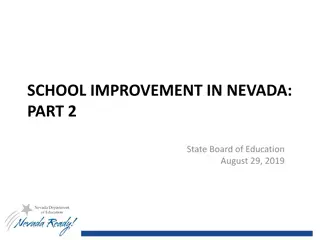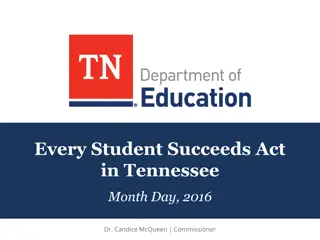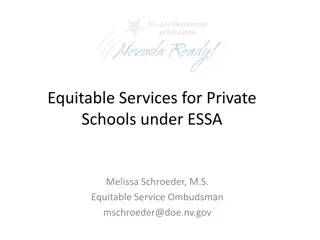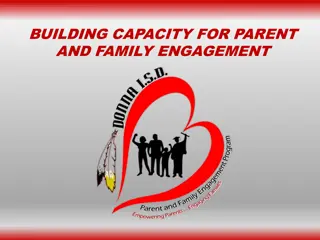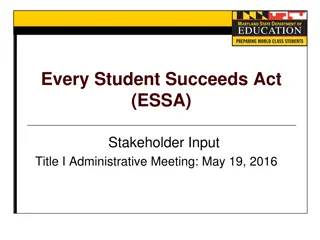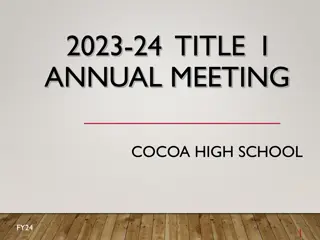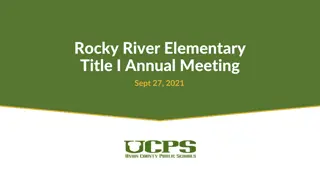Title I Committee of Practitioners & ESSA Evidence Program Overview
In this overview, Gabby Pingue, the Title I Programs Director, discusses the importance of evidence-based interventions and activities in improving student outcomes under Title I programs. The ESSA evidence levels 1-4 are explained, highlighting the criteria for each level. The focus is on supporting schools through Comprehensive Support and Improvement (CSI) and Targeted Support and Improvement (TSI) with priority given to those with the greatest need and commitment to utilizing funds effectively.
Download Presentation

Please find below an Image/Link to download the presentation.
The content on the website is provided AS IS for your information and personal use only. It may not be sold, licensed, or shared on other websites without obtaining consent from the author.If you encounter any issues during the download, it is possible that the publisher has removed the file from their server.
You are allowed to download the files provided on this website for personal or commercial use, subject to the condition that they are used lawfully. All files are the property of their respective owners.
The content on the website is provided AS IS for your information and personal use only. It may not be sold, licensed, or shared on other websites without obtaining consent from the author.
E N D
Presentation Transcript
Title I Committee of Practitioners State s ESSA Evidence and Title I 1003(a) Program Title I NDE Guidance and Spending Plan Title I-D Neglected and Delinquent Program Equitable Services for Private Schools 1
States ESSA Evidence work and Title I 1003(a) Program Gabby Pingue, Title I Programs Director and Federal Liaison Overview ESSA Section 8101 (21) and AB 7 state that activities, strategies and interventions LEAs and schools utilize must meet an evidence level 1-4. Title I 1003(a) School Improvement can only fund activities, strategies and interventions that meet ESSA evidence levels 1-3. 2
ESSA Evidence Level Description Level Research Study Criteria An activity, strategy, or intervention that demonstrates a statistically significant effect on improving student outcomes LEVEL 1: Evidence cited is based on: at least 1 well-designed and well-implemented experimental study STRONG EVIDENCE LEVEL 2: Evidence cited is based on: at least 1 well-designed and well-implemented quasi-experimental study MODERATE EVIDENCE LEVEL 3: Evidence cited is based on: at least 1 well-designed and well-implemented correlational study with statistical controls for selection bias PROMISING EVIDENCE An activity, strategy, or intervention that demonstrates a rationale that such activity, strategy, or intervention is likely to improve student outcomes LEVEL 4: Evidence cited is based on: high-quality research findings or positive evaluation, and includes ongoing efforts to examine the effects of such activity, strategy, or intervention DEMONSTRATES A RATIONALE 3
Title I 1003(a) Program Purpose Support Comprehensive Support and Improvement (CSI) and Targeted Support and Improvement (TSI) schools Implement activities, strategies and interventions that will help students meet challenging academic standards Priority is given to LEAs that: Serve high numbers, or a high percentage of, elementary schools and secondary schools implementing plans Demonstrate the greatest need Demonstrate the strongest commitment to using funds 4
Title I 1003(a) Funding Required 7% set aside of Title I, A (~$8-9 million) Data (i.e. students/schools served) CSI schools (NDE s 2017 Rising Stars List) Bottom 5% of schools based on Index Score 1-Star Rating High schools with graduation rate below 67% 5
States ESSA Evidence work and Title I 1003(a) Program Next Steps Title I 1003(a), as part of Consolidated Application, was due May 9th and review teams are reviewing this week Preliminary awards to LEAs by June 15th Guidance on supporting CSI/TSI schools later this summer NDE OSSS will host a statewide forum on ESSA evidence levels this summer/early fall Questions? 6
Title I NDE Overview Overview Title I, Part A is a State-administered program USDOE grants funds to States based on statutory formulas Nevada (State Education Agencies or SEAs) grants funds to Districts (Local Education Agencies or LEAs) based on statutory formula LEAs allocates funds to schools based on ranking and serving Purpose: Improving the Academic Achievement of the Disadvantaged 8
Title I, Pt A PRELIMINARY Allocations 2018-2019 (PRELIMINARY) Total Title I, pt. A full allocation= $129,657,418 Total Title I, pt. A administrative base allocation =$113,810,061 SEA Set Asides: Total Title I, pt. A State Admin (1% of admin base)= $1,138,100 1003(a) School Improvement Reservation (greater of 7% of SEAs FY18 full allocation OR the sum of the amount the state reserved in FY 2016 + the amount it received for FY 2016 for School Improvement Grants (SIG))= $9,076,020 Direct Student Services 1003(a) up to 3% of total allocation =$3,889,722* *NV does not use DSS; this amount rolls back into the Title IA administrative base of $113,810,061 Aid to LEAs: Title I, pt. A-Aid to Schools Set Aside Total (Title I full allocation $129,657,418 minus 1003(a) set aside $9,076,020 minus SEA 1% set aside $1,138,100; total includes the DSS 3% set aside $3,889,722 that reverted back into the full allocation) = $119,443,298 9
Title I-A Allocations & Services Allocations are based on poverty levels Services provided are based on academic need 10
(EXAMPLES) Title I, Pt. A-Grant-Supported activities aligned with NV Educational Goals and LEA/School Needs: Grant Supported Activities Goal High quality early childhood and Pre-K services Evidence based strategies to accelerate Reading Interventionists and professional development support G1 All students are proficient in reading by the end of 3rd grade. School Performance Support resources Interventionists and instructional activity supports G2 All students enter high school with the skills necessary to succeed Resource intervention and instructional activities CTE programs to prepare for postsecondary and workforce G3 All students graduate college and career ready Resources to support climate needs Professional Development support Counseling, mental health programs and wrap around services G4 All students learn in an environment that is physically, emotionally, and intellectually safe Various professional development activities Technical assistance offerings provided by experts in the field G5 All students served by effective educators Opportunities to align activities to DPP/STIP and tie to outcomes Measurement to determine resource effectiveness G6 Efficient and effective use of public funds to achieve the highest return on educational investment. *There is an opportunity for LEAs & served schools to align fiscal resources to effective activities that are tied to both LEA local needs and State priorities through the submission, review, and approval of a consolidated District and School Performance Plan 11
School Title I-A Programs: Schoolwide vs Targeted Schoolwide Program Services (SWP) 40% poverty level or higher All students can receive services (comprehensive school reform) Students identified as most at risk are given additional assistance Targeted Assistance Services (TAS) Under 40% and did not receive approval for a schoolwide program (SWP) waiver from the SEA Title I Director. 12
Comprehensive Support & Improvement (CSI) Targeted Support & Improvement (TSI) CSI Schools New 2018 TSI Schools An identified underperforming school must develop and implement a targeted support and improvement plan to improve student outcomes for each subgroup that was identified that Addresses the state s indicators. Includes evidence-based interventions. Is approved and monitored by the district. An identified TSI school is subject to additional action if it does not successfully implement its plan after a number of years. (Section 1111(d)(2)(B)) For each school identified by the state as needing comprehensive support and improvement, a district must develop and implement a plan to improve student outcomes that Addresses the state s indicators. Includes evidence-based interventions. Is based on a school-level needs assessment. Identifies resource inequities. Is approved by the school, district, and state. Is monitored and periodically reviewed. (Section 1111(d)(1)(B)) 13
Exit Criteria for CSI/TSI 1. Schools identified for comprehensive support and improvement (CSI) if not satisfied within a state determined number of years (not to exceed 4), must result in more rigorous state-determined interventions 2. Schools identified for targeted support and improvement (TSI) if not satisfied within a state-determined number of years, must result in identification of the school for comprehensive support and improvement. (Section 1111(d)(3)(A)) 14
QUESTIONS? 15
Title I-D Neglected and Delinquent Program Purpose The Part D program serves students in various settings, including those who reside in juvenile detention facilities and juvenile and adult correctional facilities, those residing in facilities for youth who are neglected, and those attending programs directed at preventing school dropout and/or delinquent involvement . Title I, Part D, State Coordinator s Orientation Handbook (I-2) 16
Title I-D Neglected and Delinquent Program Funding and Students Served Total Funding 2017/18: 1,356,216.04 Total Students Served: 6,922 17
Title I-D Neglected and Delinquent Program Three Fast Facts Facilities such as the Children s Cabinet and Kid s Kottage supplement educational resources while children are in their care. Adolescent treatment centers, juvenile courts, and detention centers work to transition students seamlessly to high school upon release. Incarcerated students continue their education through facility programs. Questions? 18
Equitable Services Ombudsman and Private Schools Melissa Schroeder 19
Equitable Services for Private Schools My Role Oversee Private School licensing for the state of Nevada Provide technical assistance to private schools as needed regarding regulations and compliance Serve as the state equitable services ombudsman 20
Equitable Services for Private Schools What You Need to Know NEW ESSA Ombudsman: Designated by the State Educational Agency to ensure equity for private school children, teachers, and other educational personnel Monitors and enforces relevant portions of the law for ALL federal programs with private school participation Meaningful consultation 21
Equitable Services for Private Schools Ombudsman Private school complaints regarding equitable services must go to the ombudsman New complaint form and consultation forms for the LEAs and private schools will be on the new ombudsman website: Nevada Department of Education Equitable Service 22
